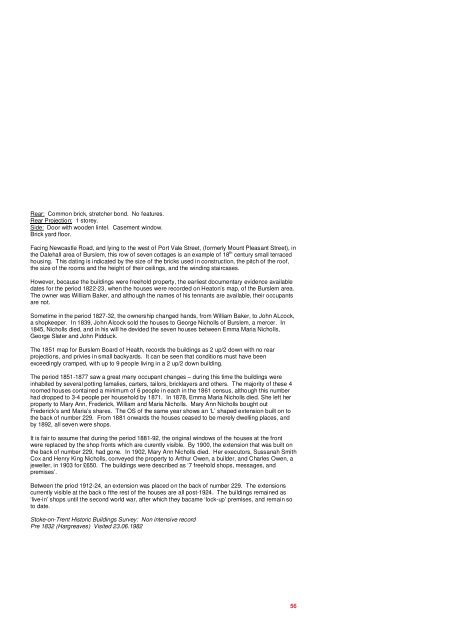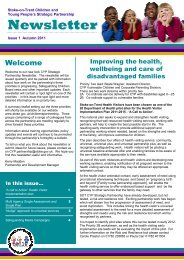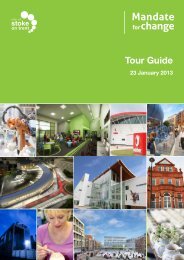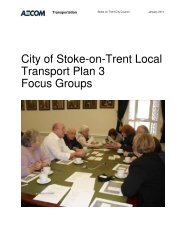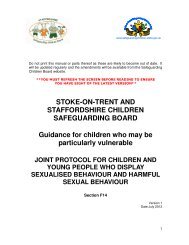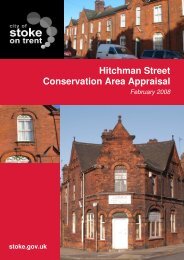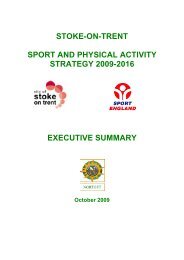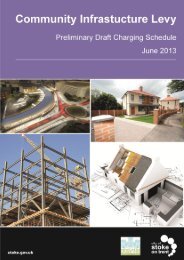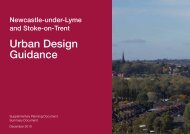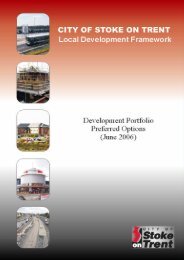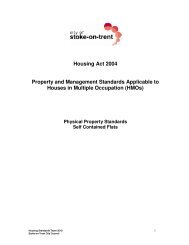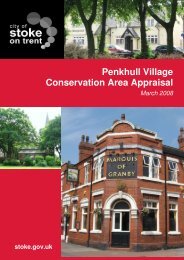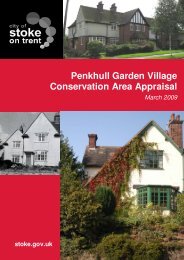Appendix B: Historic Maps of the Conservation Area
Appendix B: Historic Maps of the Conservation Area
Appendix B: Historic Maps of the Conservation Area
- No tags were found...
You also want an ePaper? Increase the reach of your titles
YUMPU automatically turns print PDFs into web optimized ePapers that Google loves.
Rear: Common brick, stretcher bond. No features.Rear Projection: 1 storey.Side: Door with wooden lintel. Casement window.Brick yard floor.Facing Newcastle Road, and lying to <strong>the</strong> west <strong>of</strong> Port Vale Street, (formerly Mount Pleasant Street), in<strong>the</strong> Dalehall area <strong>of</strong> Burslem, this row <strong>of</strong> seven cottages is an example <strong>of</strong> 18 th century small terracedhousing. This dating is indicated by <strong>the</strong> size <strong>of</strong> <strong>the</strong> bricks used in construction, <strong>the</strong> pitch <strong>of</strong> <strong>the</strong> ro<strong>of</strong>,<strong>the</strong> size <strong>of</strong> <strong>the</strong> rooms and <strong>the</strong> height <strong>of</strong> <strong>the</strong>ir ceilings, and <strong>the</strong> winding staircases.However, because <strong>the</strong> buildings were freehold property, <strong>the</strong> earliest documentary evidence availabledates for <strong>the</strong> period 1822-23, when <strong>the</strong> houses were recorded on Heaton’s map, <strong>of</strong> <strong>the</strong> Burslem area.The owner was William Baker, and although <strong>the</strong> names <strong>of</strong> his tennants are available, <strong>the</strong>ir occupantsare not.Sometime in <strong>the</strong> period 1827-32, <strong>the</strong> ownership changed hands, from William Baker, to John ALcock,a shopkeeper. In 1839, John Alcock sold <strong>the</strong> houses to George Nicholls <strong>of</strong> Burslem, a mercer. In1845, Nicholls died, and in his will he devided <strong>the</strong> seven houses between Emma Maria Nicholls,George Slater and John Pidduck.The 1851 map for Burslem Board <strong>of</strong> Health, records <strong>the</strong> buildings as 2 up/2 down with no rearprojections, and privies in small backyards. It can be seen that conditions must have beenexceedingly cramped, with up to 9 people living in a 2 up/2 down building.The period 1851-1877 saw a great many occupant changes – during this time <strong>the</strong> buildings wereinhabited by several potting famalies, carters, tailors, bricklayers and o<strong>the</strong>rs. The majority <strong>of</strong> <strong>the</strong>se 4roomed houses contained a minimum <strong>of</strong> 6 people in each in <strong>the</strong> 1861 census, although this numberhad dropped to 3-4 people per household by 1871. In 1878, Emma Maria Nicholls died. She left herproperty to Mary Ann, Frederick, William and Maria Nicholls. Mary Ann Nicholls bought outFrederick’s and Maria’s shares. The OS <strong>of</strong> <strong>the</strong> same year shows an ‘L’ shaped extension built on to<strong>the</strong> back <strong>of</strong> number 229. From 1881 onwards <strong>the</strong> houses ceased to be merely dwelling places, andby 1892, all seven were shops.It is fair to assume that during <strong>the</strong> period 1881-92, <strong>the</strong> original windows <strong>of</strong> <strong>the</strong> houses at <strong>the</strong> frontwere replaced by <strong>the</strong> shop fronts which are curently visible. By 1900, <strong>the</strong> extension that was built on<strong>the</strong> back <strong>of</strong> number 229, had gone. In 1902, Mary Ann Nicholls died. Her executors, Sussanah SmithCox and Henry King Nicholls, conveyed <strong>the</strong> property to Arthur Owen, a builder, and Charles Owen, ajeweller, in 1903 for £650. The buildings were described as ‘7 freehold shops, messages, andpremises’.Between <strong>the</strong> priod 1912-24, an extension was placed on <strong>the</strong> back <strong>of</strong> number 229. The extensionscurrently visible at <strong>the</strong> back o f<strong>the</strong> rest <strong>of</strong> <strong>the</strong> houses are all post-1924. The buildings remained as‘live-in’ shops until <strong>the</strong> second world war, after which <strong>the</strong>y bacame ‘lock-up’ premises, and remain soto date.Stoke-on-Trent <strong>Historic</strong> Buildings Survey: Non intensive recordPre 1832 (Hargreaves) Visited 23.06.198256


